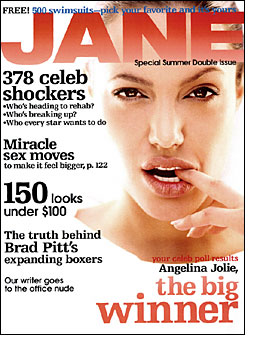Jane Magazine has an interesting sponsorship package that requires readers to actually buy advertisers products. In a promotion called, "Jane Makes You Famous", participants enter the purchased product's UPC into a section on the publication's web site and are entered into a contest. The winner gets $1,000 and a page in the magazine to write an article of their own.
Since the launch of the promotion, ad pages have gone up 29% and ad revenue has increased 52%.
Jane will continue with the success of it's UPC based promotions with a campaign in the Fall called, "Fly With Jane", that will give away airline trips and another called, "Jane Live From Where You Live", giving entrants the chance to win a concert in their backyard or at a local bar.
Could the offline industry be heading in the direction of online accountability? That would be a good thing.
--------
A while back, I ripped on Britney for getting into this mess with Skechers (among other things). Spears sued Skechers saying they used her name but not her designs for a line of roller skates. Skechers countered saying Spears didn't deliver by delaying and failing to approve the line. Now, it seems the two sides have come to a settlement.
--------
A new study out by Arbitron entitled, "The Arbitron Cinema Study", found U.S. audiences claim pre-movie advertising is more interesting than TV and more acceptable than Internet advertising. Also, 86% recall seeing ads prior to a movie.
"Worldwide, nearly a billion dollars is spent in cinema advertising, little of it in the U.S.," Pierre Bouvard, president, New Ventures, Arbitron Inc., said in a statement. "Our research indicates cinema audiences are open to advertising, and represent a large and highly attractive target audience for advertisers. The U.S. cinema advertising market is poised for growth." Yea, and I just can't wait to wait even LONGER for a movie to start!
Additional survey findings:
- Cinema delivers advertising frequency, reaching an attentive core audience that is highly educated, active and is much more likely to have a household income of above $75,000.
- Moviegoers are 85% more likely to pay $35,000 or more for a vehicle and 70% more likely to lease or buy a luxury vehicle.
- Frequent moviegoers are 50% more likely to spend $150 or more on their cellular phone bill and 41% more likely to be in the market for a cell phone.
- Among frequent moviegoers, DVDs are 73% more likely to be purchased, video games 52% and digital cameras 44%.
--------
The "Today" show co-anchor made the numbers as guest host of "The Tonight Show," as the program received a 42 percent ratings gain over its Monday night season average, according to Nielsen.
Appearing in a sexy black gown that showed off a lot of leg, Couric took over the "Tonight Show" on Monday in a one-day job swap with Jay Leno. In the monolouge, she told jokes she heard from her kids and got big laughs.
Her guests were comic actor Mike Myers, "American Idol" judge Simon Cowell and British pop star Robbie Williams. Self-help guru Dr. Phil McGraw also made a surprise walk-on appearance.
The May "sweeps" stunt made "Tonight Show" history, marking the first time someone other than Leno presided over NBC's late-night proceedings since he succeeded Johnny Carson as host in 1992.
Leno's stint on the "Today" show, however, did not do so well posting only a 9 percent uptick in ratings over regular Monday night averages. Leno conducted interviews with Secretary of State Colin Powell and former New York Mayor Rudolph Giuliani.
Joking about his "Today" show performance on the syndicated TV show "Access Hollywood, Leno said Powell was a "good sport," adding, "Why get a hard-hitting journalist when you can get softball Leno to ask you the questions?"
--------
The Online Publishers Association announced Tuesday the results of a new media consumption study focused on the At Work Internet audience (defined as users who indicated they had accessed the Internet from work in the past 30 days for non-email purposes). The study, conducted with Millward Brown IntelliQuest, confirmed that daytime on the Internet is primetime for these users. For nearly three in ten of them, the Internet is the only medium consumed during the daytime. These findings reinforce the emerging view that the At Work Internet audience is an ideal choice for advertisers seeking to reach young, highly educated, highly affluent consumers.
Probing deeper into the online activities of working people, this new study provides insights into the ways that Internet usage levels, and 13 distinct online activities, vary by demographic group and time of day. In addition, the study provides further proof that online tenure (the number of years a user has been online) is a key determinant of usage levels and activity.
"This research broadens our understanding of the At Work audience and the subtle differences in how key demographic groups use online media throughout the day," said Michael Zimbalist, executive director of the Online Publishers Association. "As we learn more about the ways consumers have integrated the Web into their daily lives, it helps clarify the importance of this medium for advertisers seeking to reach some of their most elusive targets."
Specifically, the study found that Internet usage by daypart i varies by demographics. For example, usage among top-level professionals exceeds all other At Work users during most dayparts by anywhere between five and 13 percentage points, with the greatest percentage (81%) found online in the morning before lunch (Daytime I). In addition, affluent users with annual incomes of $75k and above are more prevalent online throughout the day until evening, when average income levels of online users decline.
Generally speaking, a greater percentage of men are online than women during most weekday dayparts. While the highest percentage of both men (77%) and women (68%) can be found online during the morning before lunch (Daytime I), the greatest gender difference occurs in the Early Morning (6am to 8am), when 52% of men are online vs. only 39% of women.
For 13 surveyed online activities ranging from checking the weather to planning meals, daytime usage predominates, with the exception of shopping and multimedia downloads (a proxy in the study for online entertainment), which peak both during the daytime and also in the Prime Time TV viewing hours at night.
Online activity levels and patterns also vary by demographic group. For example, top-level professionals use the Internet in the morning to keep up with the news and to prepare for meetings, whereas shopping is dominant among this group at night. Affluent workers display similar patterns, with a slightly larger share of them engaging in online shopping activity during the lunch hour.
Other key findings from the study include:
Working women avidly check the weather during the day and use the Internet to shop in the evenings, if they use it at all;
Working mothers focus on both weather and local information during the day; they are less likely to be online in the evenings than women overall;
Younger workers show greater interest in world or local news than in business news during the day, and are somewhat less likely to be shopping than the norm;
Older workers are more apt to check stocks after the market closes than during trading hours and to seek out entertainment in the Early Morning, rather than the evenings.
For every surveyed online activity, the more tenured users (those who have been online for 7+ years) displayed higher usage levels than the least tenured users (those online four years or less). This indicates that the more familiar users become with online media, the more ways they find to integrate it into their lives.
Seventy-four percent of At Work users say that the Internet has improved their productivity at work. Fifty-six percent also indicated that they use the Internet at home for business purposes.
The research was conducted on a nationally representative sample size of 1,416 Internet users, of which 1053 had accessed the Internet from work in the past 30 days, and 363 had accessed the Internet from somewhere other than work in the past 30 days. The sample was recruited throughout the day from the Lightspeed Web panel. Interviews were conducted from Tuesday, January 14 to Saturday, January 25 to ask about weekday media consumption from the previous day.
--------
An informative article on the Internet's ability to serve both as a direct medium as well as a brand building medium. Also discussed, is an approach called "Involvement Branding" which claims to be all about creating a deep and lasting level of involvement between consumer and marketer on many levels. Both advertainment and weblogs would fall into this category. Well worth the read if you are interested in online marketing.
--------





